This is an old revision of this page, as edited by 86.20.236.242 (talk) at 16:54, 6 April 2016 (→Taxonomy and evolution). The present address (URL) is a permanent link to this revision, which may differ significantly from the current revision.
Revision as of 16:54, 6 April 2016 by 86.20.236.242 (talk) (→Taxonomy and evolution)(diff) ← Previous revision | Latest revision (diff) | Newer revision → (diff) This article is about the cat. For other uses, see Snow Leopard (disambiguation).
| Snow leopard | |
|---|---|
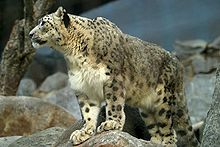
| |
| Snow leopard in the San Diego Zoo | |
| Conservation status | |
 Endangered (IUCN 3.1) | |
| Scientific classification | |
| Kingdom: | Animalia |
| Phylum: | Chordata |
| Class: | Mammalia |
| Order: | Carnivora |
| Family: | Felidae |
| Genus: | Panthera |
| Species: | P. uncia |
| Binomial name | |
| Panthera uncia (Schreber, 1775) | |
| Subspecies | |
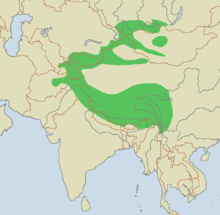
| |
| Range map | |
| Synonyms | |
The snow leopard (Panthera uncia syn. Uncia uncia) is a large cat native to the mountain ranges of Central and South Asia. It is listed as endangered on the IUCN Red List of Threatened Species because, as of 2003, the size of the global population was estimated at 4,080–6,590 adults, of which fewer than 2,500 individuals may reproduce in the wild.
Drawing from the latest available data, the Global Snow Leopard and Eco-System Protection Program (GSLEP) uses an estimate of between 3,920 and 6,390 individuals in the wild.
Snow leopards inhabit alpine and subalpine zones at elevations from 3,000 to 4,500 m (9,800 to 14,800 ft). In the northern range countries, they also occur at lower elevations.
Taxonomically, the snow leopard was classified as Uncia uncia since the early 1930s. Based on genotyping studies, the cat has been considered a member of the genus Panthera since 2008. Two subspecies have been attributed, but genetic differences between the two have not been settled.
The snow leopard is the National Heritage Animal of Afghanistan and Pakistan.
Naming and etymology
Both the latinized genus name, Uncia, and the occasional English name ounce are derived from the Old French once, originally used for the European lynx. Once itself is believed to have arisen by back-formation from an earlier variant of lynx, lonce – the "l" of lonce was construed as an abbreviated la ('the'), leaving once to be perceived as the animal's name. This, like the English version ounce, came to be used for other lynx-sized cats, and eventually for the snow leopard.
The snow leopard is also known in its native lands as "wāwrīn pṛāng" (Template:Lang-ps), "shan" (Ladakhi), "zigsa" (Tibetan), "irves" (Template:Lang-mn), "bars" or "barys" (Template:Lang-kk Template:IPA-kk), "ilbirs" (Kyrgyz: Илбирс), "barfānī chītā" Urdu: برفانی چیتا) and "him tendua" (Sanskrit, Template:Lang-hi).
According to the American Heritage Dictionary, the origin of the word panthera is unknown. A folk etymology derives the word from the Greek πάν pan ("all") and thēr (beast of prey) because they can hunt and kill almost anything. It was proposed to have come ultimately into Greek from a Sanskrit word meaning "the yellowish animal" or "whitish-yellow". The Greek word πάνθηρ, pánthēr, referred to all spotted felines generically.
Taxonomy and evolution


The scientific name of the snow leopard is Panthera uncia. It is a member of the genus Panthera and is placed in the family Felidae. The species was first described by German naturalist Johann Christian Daniel von Schreber on the basis of an illustration in his 1777 publication Die Säugethiere in Abbildungen nach der Natur mit Beschreibungen. Schreber named the cat Felis uncia and gave its type locality as Barbary, Persia, East India, and China. In 1854, British zoologist John Edward Gray proposed the genus Uncia, to which he subordinated the snow leopard under the name Uncia irbis. British zoologist Reginald Innes Pocock corroborated this classification, but attributed the scientific name Uncia uncia. He also described morphological differences between snow leopards and the then-accepted members of Panthera.
The snow leopard is part of the Panthera lineage, one of the eight lineages of Felidae. This lineage comprises the species of Panthera and Neofelis. The clouded leopard (Neofelis nebulosa) diverged first from the lineage, followed by the snow leopard. Subsequent branching began two to three million years ago, but the details of this are disputed. A 2006 phylogenetic study by Warren E. Johnson (of the National Cancer Institute) and colleagues, based on nDNA and mtDNA analysis, showed that the leopard is sister to two clades within Panthera - one consisting of the tiger and the snow leopard, and the other of the lion and the jaguar. This was seconded by a 2009 study by Lars Werdelin and colleagues. However, the results obtained in a 2010 study by Brian W. Davis (of the Texas A&M University) and colleagues and a 2011 study by Ji H. Mazák (of the Shanghai Science and Technology Museum) and colleagues showed a swapping between the leopard and the jaguar in the cladogram. A 2016 study indicates that at some point in their evolution, snow leopards interbred with lions, as their mitochondrial genomes are more similar to each other than their nuclear genomes. From this research, it is indicated that a female hybrid offspring of male ancestors of modern snow leopards and female ancestors of modern lions interbred with the male ancestors of modern snow leopards.
Subspecies
The snow leopard subspecies U. u. baikalensis-romanii was proposed for a population living in the southern Transbaikal region, which requires further evaluation. Authors of the Handbook of the Mammals of the World recognize two subspecies, namely U. u. uncia occurring in Mongolia and Russia; and U. u. uncioides living in western China and the Himalayas.
Description

Snow leopards are slightly smaller than the other big cats but, like them, exhibit a range of sizes, generally weighing between 27 and 55 kg (60 and 121 lb), with an occasional large male reaching 75 kg (165 lb) and small female of under 25 kg (55 lb). They have a relatively short body, measuring in length from the head to the base of the tail 75 to 150 cm (30 to 60 in). However, the tail is quite long, at 80 to 100 cm (31 to 39 in), with only the domestic-cat-sized marbled cat being relatively longer-tailed. They are stocky and short-legged big cats, standing about 60 cm (24 in) at the shoulder.
Snow leopards have long, thick fur, and their base color varies from smoky gray to yellowish tan, with whitish underparts. They have dark grey to black open rosettes on their bodies, with small spots of the same color on their heads and larger spots on their legs and tails. Unusually among cats, their eyes are pale green or grey in color.
Snow leopards show several adaptations for living in a cold, mountainous environment. Their bodies are stocky, their fur is thick, and their ears are small and rounded, all of which help to minimize heat loss. Their paws are wide, which distributes their weight better for walking on snow, and have fur on their undersides to increase their grip on steep and unstable surfaces; it also helps to minimize heat loss. Snow leopards' tails are long and flexible, helping them to maintain their balance, which is very important in the rocky terrain they inhabit. Their tails are also very thick due to storage of fat and are very thickly covered with fur which allows them to be used like a blanket to protect their faces when asleep.
The snow leopard has a short muzzle and domed forehead, containing unusually large nasal cavities that help the animal breathe the thin, cold air of their mountainous environment.
The snow leopard cannot roar, despite possessing partial ossification of the hyoid bone. This partial ossification was previously thought to be essential for allowing the big cats to roar, but new studies show the ability to roar is due to other morphological features, especially of the larynx, which are absent in the snow leopard. Snow leopard vocalizations include hisses, chuffing, mews, growls, and wailing.
Snow leopards were only reclassified as a member of the Panthera genus (big cats) following a genetic study by Mr Brian Davis, Dr Gang Li and Professor William Murphy in 2009. This study showed that snow leopards actually evolved alongside tigers and not leopards as previously thought.
Distribution and habitat
The snow leopard is distributed from the west of Lake Baikal through southern Siberia, in the Kunlun Mountains, in the Russian Altai mountains, Sayan and Tannu-Ola Mountains, in the Tian Shan, across Kazakhstan, Kyrgyzstan, Tajikistan, and Uzbekistan to the Hindu Kush in eastern Afghanistan, Karakoram in northern Pakistan, in the Pamir Mountains, and in the high altitudes of the Himalayas in India, Nepal, and Bhutan, and the Tibetan Plateau. In Mongolia, it is found in the Mongolian and Gobi Altai Mountains and the Khangai Mountains. In Tibet, it is found up to the Altyn-Tagh in the north.
Potential snow leopard habitat in the Indian Himalayas is estimated at less than 90,000 km (35,000 sq mi) in the states of Jammu and Kashmir, Uttarakhand, Himachal Pradesh, Sikkim, and Arunachal Pradesh, of which about 34,000 km (13,000 sq mi) is considered good habitat, and 14.4% is protected. In the beginning of the 1990s, the Indian snow leopard population was estimated at roughly 200–600 individuals living across about 25 protected areas.
In summer, snow leopards usually live above the tree line on mountainous meadows and in rocky regions at altitudes from 2,700 to 6,000 m (8,900 to 19,700 ft). In winter, they come down into the forests to altitudes around 1,200 to 2,000 m (3,900 to 6,600 ft). Snow leopards prefer rocky, broken terrain, and can travel without difficulty in snow up to 85 cm (33 in) deep, although they prefer to use existing trails made by other animals.
Global warming has caused the tree line to be increased in altitude, resulting in the decrease of wild prey that depend on the plants for food.
Ecology and behavior
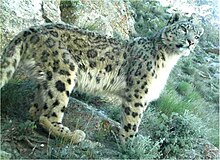
The snow leopard is solitary, except for females with cubs. They rear them in dens in the mountains for extended periods.
An individual snow leopard lives within a well-defined home range, but does not defend its territory aggressively when encroached upon by other snow leopards. Home ranges vary greatly in size. In Nepal, where prey is abundant, a home range may be as small as 12 km (5 sq mi) to 40 km (15 sq mi) and up to five to 10 animals are found here per 100 km (39 sq mi); in habitats with sparse prey, though, an area of 1,000 km (386 sq mi) supports only five of these cats.
Like other cats, snow leopards use scent marks to indicate their territories and common travel routes. These are most commonly produced by scraping the ground with the hind feet before depositing urine or scat, but they also spray urine onto sheltered patches of rock.
Snow leopards are crepuscular, being most active at dawn and dusk. They are known for being extremely secretive and well camouflaged.
Hunting and diet

Snow leopards are carnivores and actively hunt their prey. Like many cats, they are also opportunistic feeders, eating whatever meat they can find, including carrion and domestic livestock. They can kill animals two to four times their own weight, such as the bharal, Himalayan tahr, markhor, argali, horse, and camel, but will readily take much smaller prey, such as hares and birds. They are capable of killing most animals in their range with the probable exception of the adult male yak. Unusually among cats, snow leopards also eat a significant amount of vegetation, including grass and twigs. Snow leopards will also hunt in pairs successfully, especially mating pairs.

The diet of the snow leopard varies across its range and with the time of year, and depends on prey availability. In the Himalayas, it preys mostly on bharals (Himalayan blue sheep), but in other mountain ranges, such as the Karakoram, Tian Shan, Altai and Tost Mountains of Mongolia, its main prey consists of Siberian ibex and argali, a type of wild sheep, although the latter has become rarer in some parts of the snow leopard's range. Other large animals eaten when available can include various types of wild goats and sheep (such as markhors and urials), other goat-like ruminants such as Himalayan tahr and gorals, plus deer, red panda, wild boars, and langur monkeys. Smaller prey consists of marmots, woolly hares, pikas, various rodents, and birds such as the snow cock and chukar.
Considerable predation of domestic livestock occurs, which brings it into direct conflict with humans. However, even in Mongolia, where wild prey have been reduced and interactions with humans are common, domestic livestock (mainly domestic sheep) comprise less than 20% of the diet of species, with wild prey being taken whenever possible. Herders will kill snow leopards to prevent them from taking their animals. The loss of prey animals due to overgrazing by domestic livestock, poaching, and defense of livestock are the major drivers for the decreasing population of the snow leopard. The snow leopard has not been reported to attack humans, and appears to be the least aggressive to humans of all big cats. As a result, they are easily driven away from livestock; they readily abandon their kills when threatened, and may not even defend themselves when attacked.
Snow leopards prefer to ambush prey from above, using broken terrain to conceal their approach. They will actively pursue prey down steep mountainsides, using the momentum of their initial leap to chase animals for up to 300 m (980 ft). They kill with a bite to the neck, and may drag the prey to a safe location before feeding. They consume all edible parts of the carcass, and can survive on a single bharal for two weeks before hunting again. Annual prey needs appears to be 20–30 adult blue sheep.
Reproduction and life cycle


Snow leopards are unusual among large cats in that they have a well-defined birth peak. They usually mate in late winter, marked by a noticeable increase in marking and calling. Snow leopards have a gestation period of 90–100 days, so the cubs are born between April and June. Oestrus typically lasts from five to eight days, and males tend not to seek out another partner after mating, probably because the short mating season does not allow sufficient time. Paired snow leopards mate in the usual felid posture, from 12 to 36 times a day.
The mother gives birth in a rocky den or crevice lined with fur shed from her underside. Litter sizes vary from one to five cubs, but the average is 2.2. The cubs are blind and helpless at birth, although already with a thick coat of fur, and weigh from 320 to 567 g (11.3 to 20.0 oz). Their eyes open at around seven days, and the cubs can walk at five weeks and are fully weaned by 10 weeks. Also when they are born, they have full black spots which turn into rosettes as they grow to adolescence.
The cubs leave the den when they are around two to four months of age, but remain with their mother until they become independent after around 18–22 months. Once independent, they may disperse over considerable distances, even crossing wide expanses of flat terrain to seek out new hunting grounds. This likely helps reduce the inbreeding that would otherwise be common in their relatively isolated environments. Snow leopards become sexually mature at two to three years, and normally live for 15–18 years, although in captivity they can live for up to 25 years.
Conservation efforts
Numerous agencies are working to conserve the snow leopard and its threatened mountain ecosystems. These include the Snow Leopard Trust, the Snow Leopard Conservancy, the Snow Leopard Network, the Cat Specialist Group, and the Panthera Corporation.
These groups and various national governments from the snow leopard’s range, nonprofits, and donors from around the world worked together at the 10th International Snow Leopard Conference in Beijing. Their focus on research, community programs in snow leopard regions, and education programs are aimed at understanding the cat's needs, as well as the needs of the villagers and herder communities juxtaposed with the snow leopards' habitats.
Global Snow Leopard Forum
In 2013 government leaders and officials from all 12 countries encompassing the snow leopard's range (Afghanistan, Bhutan, China, India, Kazakhstan, Kyrgyz Republic, Mongolia, Pakistan, Russia, Tajikistan, and Uzbekistan) came together at the Global Snow Leopard Forum (GSLF) initiated by the President Almazbek Atambayev of the Kyrgyz Republic, and the State Agency on Environmental Protection and Forestry under the government of the Kyrgyz Republic. The meeting was held in Bishkek, the capital of the Kyrgyz Republic, and all countries agreed that the snow leopard and the high mountain habitat it lives in need trans-boundary support to ensure a viable future for snow leopard populations, as well as to safeguard their fragile environment. The event brought together many partners, including NGOs like the Snow Leopard Conservancy, the Snow Leopard Trust, and the Nature and Biodiversity Conservation Union. Also supporting the initiative were the Snow Leopard Network, the World Bank's Global Tiger Initiative, the United Nations Development Programme, the World Wild Fund for Nature, the United States Agency for International Development, and Global Environment Facility.
Bishkek Declaration
At the GSLF meeting, the 12 range countries signed the Bishkek Declaration to "acknowledge that the snow leopard is an irreplaceable symbol of our nations' natural and cultural heritage and an indicator of the health and sustainability of mountain ecosystems; and we recognize that mountain ecosystems inhabited by snow leopards provide essential ecosystem services, including storing and releasing water from the origins of river systems benefitting one-third of the world’s human population; sustaining the pastoral and agricultural livelihoods of local communities which depend on biodiversity for food, fuel, fodder, and medicine; and offering inspiration, recreation, and economic opportunities."
Global Snow Leopard and Eco-system Protection Program
Out of these efforts was formed a cooperative support effort, the Global Snow Leopard and Eco-system Protection Program (GSLEP). The GSLEP is a joint initiative of range country governments, international agencies, civil society, and the private sector. Its goal is to secure the long-term survival of the snow leopard in its natural ecosystem.
The goal of the GSLEP is for the 12 snow leopard range countries, with support from conservation agencies, NGO’s and others to work together to identify and secure at least 20 healthy populations of snow leopards across the cat’s range by 2020, or "20 by 2020". Many of these populations will cross international boundaries.
The three criteria that will secure healthy populations of snow leopards are populations which represent at least 100 breeding age snow leopards, contain adequate and secure prey populations and have connectivity to other snow leopard populations.
This is an interim goal for the years through to 2020. During the coming years, agreement will be reached on the steps needed to achieve the ultimate goal of ensuring that healthy snow leopard populations remain the icon of the mountains of Asia for generations to come.
2015 designated International Year of the Snow Leopard
To help spread the word amongst the people, government authorities, and conservation groups in each range country, 2015 was designated the International Year of the Snow Leopard as part of the GSLEPP's work. All range-country governments, nongovernmental and inter-governmental organizations, local communities, and various private sector businesses pledged to take the year as an opportunity to further work towards conservation of snow leopards and their high-mountain ecosystems.
Population and protected areas

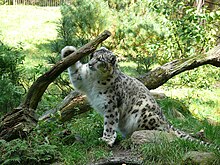
The total wild population of the snow leopard was estimated at 4,510 to 7,350 individuals. Many of these estimates are rough and outdated.
In 1972, the International Union for Conservation of Nature (IUCN) placed the snow leopard on its Red List of Threatened Species as endangered; the same threat category was applied in the assessment conducted in 2008.
There are also approximately 600 snow leopards in zoos around the world.
| Range Country | Habitat Area (km) |
Estimated Population |
|---|---|---|
| Afghanistan | 50,000 | 100–200? |
| Bhutan | 15,000 | 100–200? |
| China | 1,100,000 | 2,000–2,500 |
| India | 75,000 | 200–600 |
| Kazakhstan | 50,000 | 180–200 |
| Kyrgyzstan | 105,000 | 150–500 |
| Mongolia | 101,000 | 500–1,000 |
| Nepal | 30,000 | 300–500 |
| Pakistan | 80,000 | 200–420 |
| Tajikistan | 100,000 | 180–220 |
| Uzbekistan | 10,000 | 20–50 |

Protected areas:
- Chitral National Park, in the Khyber-Pakhtunkhwa, Pakistan
- Hemis National Park, in Ladakh, Jammu and Kashmir, India
- Khunjerab National Park, Gilgit-Baltistan, Pakistan
- Nanda Devi National Park, in state of Uttarakhand, India, a UNESCO Natural World Heritage Site
- Qomolangma National Nature Preserve, Tibet, China
- Sagarmatha National Park, Nepal, a UNESCO Natural World Heritage Site.
- Tumor Feng Nature Reserve, western Tianshan Mountains, Xinjiang, China.
- Valley of Flowers National Park, Uttarakhand, India, a UNESCO Natural World Heritage Site
- Shey-Phoksundo National Park, Dolpa, Nepal
- Dhorpatan Hunting Reserve, Baglung, Nepal
- Annapurna Conservation Area, Western Nepal
- Api Nampa Conservation Area, Western Nepal
- Jigme Dorji National Park, Bhutan
- Gobi Gurvansaikhan National Park, Mongolia
- Ubsunur Hollow, on the territorial border of Mongolia and the Republic of Tuva, Russia
- Dibang Wildlife Sanctuary, near Anini, India
- Aksu-Djabagly Nature Reserve, Kazakhstan
- Sarychat-Ertash State Nature Reserve, Kyrgyzstan
- Katun Nature Reserve, Russia
- Kibber Wildlife Sanctuary, Lahaul Spiti, Himachal Pradesh, India
- Pin Valley National Park, Lahaul Spiti, Himachal Pradesh, India
- Great Himalayan National Park, Kullu, Himachal Pradesh, India
- Sacred Himalayan Landscape, Nepal, India, Bhutan
Much progress has been made in securing the survival of the snow leopard, with them being successfully bred in captivity. The animals usually give birth to two to three cubs in a litter, but can give birth to up to seven in some cases.
A "surprisingly healthy" population of snow leopards has been found living at 16 locations in the isolated Wakhan Corridor in northeastern Afghanistan, giving rise to hopes for survival of snow leopards in that region.
Relationships with humans
Attacks on humans and livestock
Snow leopard attacks on humans are rare; only two instances are known. On July 12, 1940, in Maloalmaatinsk gorge near Almaty, a rabid snow leopard attacked two men during the day and inflicted serious injuries on both. In the second case, not far from Almaty, an old, toothless, emaciated snow leopard unsuccessfully attacked a passerby in winter; it was captured and carried to a local village. There are no other records of any snow leopard attacking a human being.
A 2008 Natural World episode, "Snow Leopard – Beyond the Myth", interviewed a couple with a goat farm in Pakistan; the woman was bowled over by snow leopard escaping an enclosure where it had been feeding on the livestock, but she was not attacked by the cat, despite fainting and being helpless. The film crew went to some lengths to demonstrate that the cat was primarily hunting wild prey and was often ranging far outside the area, as they hoped to prevent local farmers from shooting it. Nevertheless, they also found evidence of other sightings of the cats around nearby human settlements, and of repeated attacks on livestock (some of them unsuccessful). Predation of livestock by snow leopards has also been a subject of conservation journal papers.
Emblematic use

Snow leopards have symbolic meaning for Turkic peoples of Central Asia, where the animal is known as irbis or bars, so it is widely used in heraldry and as an emblem.
The snow leopard in heraldry is sometimes known in English as the ounce. The cat has long been used as a political symbol, the Aq Bars ('White Leopard'), by Tatars, Kazakhs, and Bulgars, among others. A snow leopard is found on the official seal of the city of Almaty, Kazakhstan, and the former 10,000 Kazakhstani tenge banknote also featured one on the reverse. A mythical winged Aq Bars is found in the national coat of arms of Tatarstan, the seal of the city of Samarqand, Uzbekistan, and (also with a crown) the old coat of arms of the Kazakh capital, Astana. In Kyrgyzstan, it has been used in highly stylized form in the modern emblem of the capital, Bishkek, and the same art has been integrated into the badge of the Kyrgyzstan Girl Scouts Association. A crowned snow leopard features in the arms of Shushensky District, Krasnoyarsk Krai, Russia. The animal has also featured in the coat of arms of Ossetia since 1735, and has been adopted into those of modern-day North Ossetia-Alania and two entities claiming to be the legitimate government of South Ossetia.
The Snow Leopard award, given to Soviet mountaineers who scaled all five of the Soviet Union's 7,000-meter peaks, is named after the animal, but does not depict one.
The cat is the state animal of Himachal Pradesh, a north Indian state in the western Himalayas. The animal has also been declared the "National Heritage Animal" of Pakistan.
-
 Symbol of Almaty, Kazakhstan
Symbol of Almaty, Kazakhstan
-
 Snow leopard on the reverse of the old 10,000-Kazakhstani tenge banknote
Snow leopard on the reverse of the old 10,000-Kazakhstani tenge banknote
-
 The coat of arms of Tatarstan
The coat of arms of Tatarstan
-
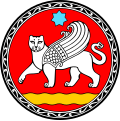 Seal of Samarqand, Uzbekistan
Seal of Samarqand, Uzbekistan
-
 Old coat of arms of Astana, Kazakhstan
Old coat of arms of Astana, Kazakhstan
-
 Symbol of Bishkek, Kyrgyzstan
Symbol of Bishkek, Kyrgyzstan
-
 Membership badge of the Girl Scout Association of Kyrgyzstan
Membership badge of the Girl Scout Association of Kyrgyzstan
-
 Coat of arms of Shushensky District, Krasnoyarsk Krai
Coat of arms of Shushensky District, Krasnoyarsk Krai
- As featured in the coat of arms of Ossetia and its successor states As featured in the coat of arms of Ossetia and its successor states
In the media
Documentary
Documentary footage of the snow leopard is scarce. While such coverage would not be remarkable with regard to common species, wildlife video of the snow leopard is difficult to obtain due to the animal's rarity and the human inaccessibility of much of its natural habitat.
The BBC One TV series Planet Earth had a segment on snow leopards. The series took some of the first video of snow leopards in the wild, and also featured a snow leopard hunting a markhor.
Nisar Malik, a Pakistani journalist, and Mark Smith, a cameraman who had worked on the Planet Earth segment, spent a further 18 months filming snow leopards in the Hindu Kush for the BBC Two series Natural World episode "Snow Leopard – Beyond the Myth". The cat has been featured in segment of other episodes of the same series.
The PBS/WNET series Nature focused on the species in its episode "Silent Roar: Searching for the Snow Leopard".
Fictional
In the 2013 film The Secret Life of Walter Mitty, photojournalist Sean O'Connell (played by Sean Penn) is shown photographing snow leopards in Afghanistan.
In Philip Pullman's 1995-2000 fantasy trilogy His Dark Materials, Lord Asriel's dæmon is a snow leopard named Stelmaria.
Tai Lung, the main antagonist of the 2008 film Kung Fu Panda, is an anthropomorphized snow leopard.
References
- ^ Template:IUCN
- ^ Wozencraft, W. C. (2005). "Order Carnivora". In Wilson, D. E.; Reeder, D. M. (eds.). Mammal Species of the World: A Taxonomic and Geographic Reference (3rd ed.). Johns Hopkins University Press. p. 548. ISBN 978-0-8018-8221-0. OCLC 62265494.
- "Who We Are Global Snow Leopard & Ecosystem Protection Program". www.globalsnowleopard.org. Retrieved 2015-10-30.
- ^ McCarthy, T. M.; Chapron, G. (eds.) (2003). Snow Leopard Survival Strategy. Seattle, USA: International Snow Leopard Trust and Snow Leopard Network.
{{cite book}}:|first2=has generic name (help) - Janecka, J. E.; Jackson, R.; Zhang, Y.; Diqiang Li, Munkhtsog; Buckley-Beason, V.; Murphy, W. J. (2008). "Population Monitoring of Snow Leopards Using Noninvasive Genetics". Cat News. 48: 7–10.
- "National Symbols and Things of Pakistan". Government of Pakistan. Retrieved 2013-11-27.
- Allen, Edward A (1908). "English Doublets". Publications of the Modern Language Association of America. 23 (new series 16): 214.
- Oxford English Dictionary, Oxford University Press. 1933: Ounce
- Wozencraft, W. C. (2005). "Order Carnivora". In Wilson, D. E.; Reeder, D. M. (eds.). Mammal Species of the World: A Taxonomic and Geographic Reference (3rd ed.). Johns Hopkins University Press. p. 548. ISBN 978-0-8018-8221-0. OCLC 62265494.
- Scheber, J.C.D. (1777). "Theil 3: Die Kaze. Felis. (Illustration of Felis uncia)". Die Säugethiere in Abbildungen nach der Natur mit Beschreibungen. 3 (22): 386–7.
- Gray, J.E. (1854). "The ounces". Annals and Magazine of Natural History. 2nd series (14): 394.
- Pocock, R. I. (1930). "The panthers and ounces of Asia. Part II. The panthers of Kashmir, India, and Ceylon". Journal of the Bombay Natural History Society. 34 (2): 307–36.
- Turner, A. (1987). "New fossil carnivore remains from the Sterkfontein hominid site (Mammalia: Carnivora)". Annals of the Transvaal Museum. 34: 319–47.
- Johnson, W.E.; Eizirik, E.; Pecon-Slattery, J.; Murphy, W.J.; Antunes, A.; Teeling, E.; O'Brien, S.J. (2006). "The late Miocene radiation of modern Felidae: a genetic assessment". Science (New York). 311 (5757): 73–7. PMID 16400146.
- Werdelin, L.; Yamaguchi, N.; Johnson, W.E.; O'Brien, S.J. (2010). "Phylogeny and evolution of cats (Felidae)" (PDF). Biology and Conservation of Wild Felids: 59–82.
- Davis, B.W.; Li, G.; Murphy, W.J. (2010). "Supermatrix and species tree methods resolve phylogenetic relationships within the big cats, Panthera (Carnivora: Felidae)" (PDF). Molecular Phylogenetics and Evolution. 56 (1): 64–76. doi:10.1016/j.ympev.2010.01.036.
- Mazák, J.H.; Christiansen, P.; Kitchener, A.C.; Goswami, A. (2011). "Oldest known pantherine skull and evolution of the tiger". PLoS ONE. 6 (10): e25483. doi:10.1371/journal.pone.0025483.
{{cite journal}}: CS1 maint: unflagged free DOI (link) - Li, G.; Davis, B.W.; Eizirik, E.; Murphy, W.J. (2016). "Phylogenomic evidence for ancient hybridization in the genomes of living cats (Felidae)". Genome Research. 26 (1): 1–11. doi:10.1101/gr.186668.114.
- Medvedev, D. G. (2000). Morfologicheskie otlichiya irbisa iz Yuzhnogo Zabaikalia [Morphological differences of the snow leopard from Southern Transbaikalia]. Vestnik Irkutskoi Gosudarstvennoi sel'skokhozyaistvennoi akademyi , vypusk 20:20–30 (in Russian).
- Handbook of the Mammals of the World. Vol. 1. Carnivores. Barcelona, Spain: Lynx Edicions. 2009. ISBN 978-84-96553-49-1.
{{cite book}}: Unknown parameter|authors=ignored (help) - Boitani, Luigi (1984) Simon & Schuster's Guide to Mammals. Simon & Schuster/Touchstone Books, ISBN 978-0-671-42805-1
- Hemmer, Helmut (1972). "Uncia uncia" (PDF). Mammalian Species. 20 (20): 1–5. doi:10.2307/3503882. JSTOR 3503882.
- http://animals.nationalgeographic.com/animals/mammals/snow-leopard/?source=A-to-Z
- ^ Sunquist, Mel; Sunquist, Fiona (2002). Wild cats of the World. Chicago: University of Chicago Press. pp. 377–394. ISBN 0-226-77999-8.
- ^ "Snow Leopard Fact Sheet" (PDF). snowleopard.org. 2008. Retrieved 2008-07-03.
- Physical Features. SnowLeopard.org
- ^ Chadwick, Douglas H. (2008). "Out of the Shadows". National Geographic. Retrieved 2010-01-29.
- ^ Nowak, Ronald M. (1999). Walker's Mammals of the World. Johns Hopkins University Press. ISBN 0-8018-5789-9.
- Weissengruber, G. E.; Forstenpointner, G.; Peters, G.; Kübber-Heiss, A.; Fitch, W. T. (September 2002). "Hyoid apparatus and pharynx in the lion (Panthera leo), jaguar (Panthera onca), tiger (Panthera tigris), cheetah (Acinonyx jubatus) and domestic cat (Felis silvestris f. catus)". Journal of Anatomy. 201 (3): 195–209. doi:10.1046/j.1469-7580.2002.00088.x. PMC 1570911. PMID 12363272.
- Geptner, V. G., Sludskii, A. A. (1992). Mammals of the Soviet Union: Carnivora (Hyaenas and Cats). Brill. ISBN 978-90-04-08876-4.
{{cite book}}: CS1 maint: multiple names: authors list (link) - Ebrahim, Zofeen (May 5, 2015). "Climate change stalks the snow leopard". scidev.net. Retrieved May 21, 2015.
- ^ Johansson, Ö.; McCarthy, T.; Samelius, G.; Andrén, H.; Tumursukh, L: Mishra, C., Gustaf; Andrén, Henrik; Tumursukh, Lkhagvasumberel; Mishra, Charudutt (2015). "Snow leopard predation in a livestock dominated landscape in Mongolia" (PDF). Biological Conservation. 184: 251–258. doi:10.1016/j.biocon.2015.02.003. Retrieved 25 March 2015.
{{cite journal}}: CS1 maint: multiple names: authors list (link) - Macri, A. M. and E. Patterson-Kane (2011). "Behavioural analysis of solitary versus socially housed snow leopards (Panthera uncia), with the provision of simulated social contact". Applied Animal Behaviour Science. 130 (3–4): 115–123. doi:10.1016/j.applanim.2010.12.005.
- ^ Jackson, Rodney; Hunter, Don O. (1996). "Snow Leopard Survey and Conservation Handbook Part III" (PDF). Snow Leopard Survey and Conservation Handbook. Seattle, Washington, & Fort Collins Science Center, Colorado, US: International Snow Leopard Trust & U.S. Geological Survey. p. 66. Retrieved 2009-03-14.
- ^ Shehzad, Wasim; McCarthy, Thomas Michael; Pompanon, Francois; Purevjav, Lkhagvajav; Coissac, Eric; Riaz, Tiayyba; Taberlet, Pierre (2012). Desalle, Robert (ed.). "Prey Preference of Snow Leopard (Panthera uncia) in South Gobi, Mongolia". PLoS ONE. 7 (2): e32104. Bibcode:2012PLoSO...732104S. doi:10.1371/journal.pone.0032104. PMC 3290533. PMID 22393381.
{{cite journal}}: CS1 maint: unflagged free DOI (link) - The oldest snow leopard in the world, Article about Shynghyz in Tama Zoo, Tokyo
- Theile, Stephanie (2003) "Fading footprints; the killing and trade of snow leopards". TRAFFIC International, ISBN 1858502012
- "Cats in the Clouds", Australian Broadcasting Corporation (2009-05-06). Retrieved 27 June 2009.
- "Bishkek Declaration", Global Snow Leopard Forum October 2013. Retrieved 2015-02-27.
- Securing at least 20 healthy populations of snow leopards across the cat’s range by 2020, Global Snow Leopard and Eco-System protection Program October 2013. Retrieved 2015-04-15.
- "International Year of the Snow Leopard", Saving Snow Leopards Report (2015-02-06). Retrieved 2015-02-27.
- McCarthy, T. M. and Chapron, G. (2003). Snow Leopard Survival Strategy (PDF). Seattle, USA: ISLT and SLN. p. 15 and Table II.
{{cite book}}: CS1 maint: multiple names: authors list (link) - UNESCO World Heritage Centre Nanda Devi and Valley of Flowers National Parks. Retrieved 27 November 2006.
- "Qomolangma National Nature Preserve". FutureGenerations China. Retrieved March 2, 2015.
- Jackson, Rodney People-Wildlife Conflict Management in the Qomolangma Nature Preserve, Tibet, pp. 40–46 in Tibet’s Biodiversity: Conservation and Management. Proceedings of a Conference, August 30 – September 4, 1998. Edited by Wu Ning, D. Miller, Lhu Zhu and J. Springer. Tibet Forestry Department and World Wide Fund for Nature. China Forestry Publishing House
- UNESCO World Heritage Center. Sagarmatha National Park: Brief Description. Retrieved 27 November 2006.
- Ming, Ma; Snow Leopard Network (2005). Camera Trapping of Snow Leopards in the Muzat Valley. Retrieved 27 November 2006.
- Farmer, Ben (2011-07-15). "Snow Leopards found in Afghanistan." The Telegraph.
- ^ Heptner, V.G.; and Sluskii, A.A. (1992) Mammals of the Soviet Union. Vol 2, Part 2. (Carnivores: Hyaenas and Cats) New Delhi: Amerind Publishing. p. 308.
- Inskip, C.; Zimmermann, A. (2009). "Human-felid conflict: A review of patterns and priorities worldwide". Oryx. 43 (1): 18–34. doi:10.1017/S003060530899030X.
- Nowell, K.; Jackson, P., eds. (1996). Wild cats: Status survey and conservation action plan. Gland, Switzerland: International Union for Conservation of Nature. pp. 193–195. ISBN 9782831700458. Retrieved 21 March 2013.
- ^ Snow Leopard – Beyond the Myth. Natural World. 4 January 2008.
{{cite AV media}}:|access-date=requires|url=(help); Unknown parameter|episodelink=ignored (help); Unknown parameter|network=ignored (help); Unknown parameter|serieslink=ignored (help); Unknown parameter|seriesno=ignored (help) - "National Symbols and Things of Pakistan". Government of Pakistan. Retrieved 2013-11-27.
- Press Office – Planet Earth firsts. BBC (2006-02-01). Retrieved 2012-08-23.
- BBC Two – Natural World, 2007–2008, Snow Leopard- Beyond the Myth. BBC.co.uk (2008-09-23). Retrieved 2012-08-23.
External links
- Snow Leopard Network
- Snow Leopard Trust
- Saving Snow Leopards Report
- Snow Leopard Conservancy
- Panthera Snow Leopard Program
- WWF Snow Leopard Program
- Global Snow Leopard & Eco-system Protection Program
- IUCN/SSC Cat Specialist Group species portrait of the snow leopard
- National Geographic snow leopard winter photography gallery
- Wildscreen Arkive images and video of the Snow leopard
- PBS Nature: "Silent Roar: Searching for the Snow Leopard"
- Video footage from the BBC including a snow leopard hunt
- World Wildlife Federation snow leopard species profile
- Wildlife Times editorial on snow leopard conservation
- Paradise Wildlife Park article about snow leopards evolving alongside tigers, not leopards
| Big cats on the Indian subcontinent | |
|---|---|
| Extant in the wild |
|
| Extirpated from India |
|
| Under reintroduction |
|